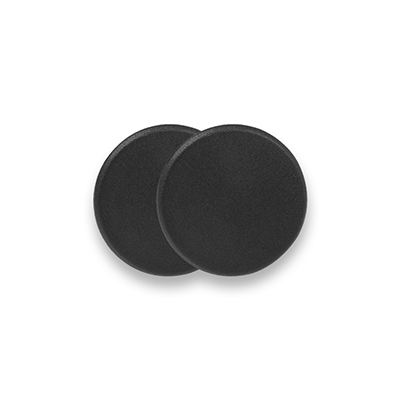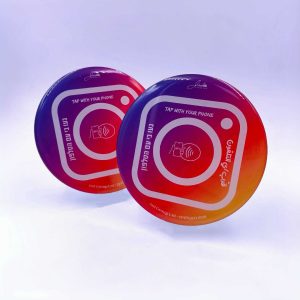RFID technology consists of three components: RFID tags, RFID readers, and RFID software. These components collaborate to track, manage, and store information about RFID-tagged objects.
RFID tags are small devices with a chip and an antenna. The chip stores data about the object it is attached to, and the antenna allows the tag to communicate with an RFID reader. This article discusses the various types of RFID tags and how they are used.
What exactly are RFID tags?
Before we get into the different types, let’s define what an RFID tag is. An RFID tag is a device that stores data about the object it is attached to. The tag communicates with an RFID reader via radio waves, which sends the data to a computer for processing.
RFID tags are available in a variety of shapes and sizes, as well as different materials depending on their intended use. Some tags are the size of a grain of rice, while others are larger and more robust.
An RFID tag’s architecture typically consists of three major components:
RFID Tag. This is the tiniest part of a tag. It has a memory that can store small amounts of data, primarily the unique identification number of the object. This number can be re-written (only for read/write tags), allowing the tag to be reused.
Antenna for RFID. This component transmits and receives radio waves, which enables the tag to communicate with an RFID reader. The range at which the tag can be read is determined by the size and shape of the antenna.
Housing or Substrate? This section of the tag safeguards the chip and antenna against damage. It also determines the form factor and size of the tag. It can be made of various materials, such as plastics and fabric.
In most cases, these components are encapsulated in a single unit, though the antenna may be separate from the chip and housing in some cases. They must, however, all be in perfect working order for the tag to function properly.
RFID Tag Categorization
While there are numerous types of RFID tags, they can be broadly classified as follows:
Power supply. This refers to how the tag obtains its strength. Some tags include a battery that powers the device, whereas others rely on the energy transmitted by the RFID reader to function.
Type of memory. Memory is classified into two types: read-only and read/write. At the time of manufacture, read-only tags are pre-programmed chips with a unique identification number. This number cannot be changed or rewritten in any way. Read/write tags, on the other hand, have a blank chip that can be programmed with new data.
Frequency of operation. RFID tags operate at various frequencies, depending on the application. Low frequency (LF), high frequency (HF), and ultra-high frequency (UHF) are the three main frequency ranges (UHF). Each range has advantages and disadvantages, which will be discussed further below.
Power Source Based Classification
RFID tags are classified based on their power source. RFID tags are classified into two types: active and passive.
RFID Active Tags
These tags have a power source built in, which is usually a battery. This allows the tag to send radio waves over long distances, usually up to 100 meters.
Active tags are more expensive and require more maintenance than passive tags. Because active tags have a limited battery life, they must be replaced more frequently.
Active tags are less popular than passive tags due to the replacement requirements and high procurement costs. They are, however, still used in applications that require long read ranges, such as inventory management and asset tracking.
RFID Passive Tags
These tags lack an internal power source and rely on the energy transmitted by the RFID reader to operate. The RFID reader sends a radio wave that energizes and powers up the tag. This energy is used by the tag to transmit its signal back to the reader.
Inductive coupling is the name given to this technology. The amount of power transferred to the tag is determined by the distance between the tag and the reader. The tag will not receive enough power if it is too far away.
Passive RFID tags are less expensive than active RFID tags and do not require maintenance. As a result, they are more widely used than active tags. They are commonly used in applications that require short read ranges, such as event management and supply chain tracking.
Memory Type-Based Classification
RFID tags can also be classified based on their memory type. As previously stated, there are two types of memory: read-only and read/write.
RFID Tags That Can Only Be Read
These tags, as the name implies, can only be read and cannot be rewritten. They can be factory-programmed with a unique identification number or programmed later with an encoder.
The tag cannot be changed after it has been encoded. This is because read-only memory is typically locked to prevent unauthorized or accidental changes.
RFID tags that are read-only are less expensive than read/write tags and do not require special programming devices. They are frequently used in applications that require data to be read but not changed, such as product identification.
They can also be used in ticketing situations where the data must be read but the ticket cannot be reused. A one-time-use event ticket, for example, cannot be copied or altered in any way.
They are typically inexpensive and widely available, making them more popular for these applications. World Cup matches, for example, have used read-only RFID tags ticketing system to prevent ticket fraud and reduce costs.
RFID Tags with Read/Write Capabilities As the name implies, these tags can be read and rewritten as needed. They have a blank chip on which new data can be programmed using a programmer.
Read/write RFID tags are more expensive than read-only tags and necessitate the use of specialized programming devices. They are frequently used in applications where data must be read and updated on a regular basis, such as employee management.
They are also useful in access control, where data is updated whenever a user is added or removed from the system. When an employee is promoted or transferred to a different department, their access privileges may be updated.
Frequency-Based Classification
This is most likely the most important classification because it determines the read range and other performance parameters. RFID tags can operate at a variety of frequencies, the most common of which are low frequency (LF), high frequency (HF), and ultra-high frequency (UHF) (UHF).
RFID Low-Frequency Tags (125-134.2 kHz)
The read range of LF tags is approximately 10 cm (4 inches). Because they lack adequate anti-collision mechanisms, they can only be read one at a time.
Their data transmission rate is also slow, typically ranging between 10 and 20 bits per second. This is due to the low frequency of the LF signal, which does not carry much data.
LF tags are frequently used in applications requiring short read ranges, such as livestock tracking (as defined by ISO 14223 and ISO/IEC 18000-2). They are also used in asset management and access control.
Their antennae are constructed of copper coils wrapped around a ferrous core. They are relatively expensive due to the high cost of production.
RFID tags with a high frequency of operation (13.56 MHz)
The read range of HF/NFC RFID inlays/tags is approximately 30 cm (12 inches) to 1 meter. Because they have adequate anti-collision mechanisms, they can be read individually or in groups.
Their data transmission rate is also slow, at approximately 106 bits per second. Their antennae are made of 3-7 coils of aluminum, copper, or silver. They are less expensive to produce (in comparison to LF tags), making them more affordable.
RFID standards such as ISO 15693 (asset tracking), ISO/IEC 14443 A & ISO/IEC 14443 (MIFARE), ECMA-340 & ISO/IEC 18092 (NFC), and JIS X 6319-4 are used to control them (FeliCa).
This technology is used in a variety of applications, such as contactless payments, public transportation, access control, and asset tracking.
RFID Tags with Ultra-High Frequency (868 MHz to 956 MHz)
The read range of UHF RFID inlays/tags is approximately 1 meter to 10 meters. Because they have adequate anti-collision mechanisms, they can be read in groups.
Because of their high data transmission rate, they are well suited for large-scale applications. UHF tags are also relatively inexpensive to produce, making them more affordable.
They are sensitive to metal and water, limiting their applications. Metal-mount RFID tags, on the other hand, have been modified to overcome this challenge.
These tags can be active or passive. RFID UHF passive tags use the reader’s signal to power up and communicate. The power source for active UHF RFID tags is typically a battery.
In any case, these tags have a much greater read range than other RFID tags. They have the ability to communicate over long distances, making them ideal for large-scale applications like supply chain management and vehicle tracking.
















